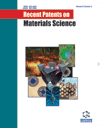- Home
- A-Z Publications
- Recent Patents on Materials Science
- Previous Issues
- Volume 11, Issue 1, 2018
Recent Patents on Materials Science - Volume 11, Issue 1, 2018
Volume 11, Issue 1, 2018
-
-
Energy Absorption Mechanisms and Impact Strength Modification in Multiphase Biopolymer Systems
More LessAuthors: Matthew J. Smith and Casparus J. R. VerbeekA major drawback of some polymers is their low impact resistance and ability to absorb energy during fracture, such as PS, PMMA and PVC. Several techniques are used to toughen or modify impact resistance of brittle polymers, including reinforcement such as fibers and particles, or the incorporation of an elastomeric second phase. Whilst synthetic polymers can provide desirable properties for a wide variety of applicatio Read More
-
-
-
Synthesis and Growth Mechanism of Cu Nanorods via Liquid-Phase Reduction of Cu2O Cubes
More LessAuthors: Yifan Zheng, Jie Zhang and Zongjian LiuBackground: The synthesis of one-dimensional Cu nanomaterials, e.g. nanowires or nanorods, normally invovles the use of hard templates, organic additives, or some special conditions, e.g. high vacuum or electric field as discussed in patents. Objective: Herein, we report that, in the absence of any hard template and organic additives, Cu nanorods can be spontaneously formed during low-temperature reduction of Cu2O cubes. Read More
-
-
-
Time-order Phonon Scattering Processes are Responsible for the Asymmetric G* Raman Band in Graphene
More LessAuthors: Jingyi Zhu, Rahul Rao, Apparao M. Rao and Ramakrishna PodilaBackground: While most of the prominent features in the Raman spectrum of graphene are well understood as mentioned in patents within the Double Resonance (DR) picture, the origin of the peak at 2450 cm-1 (also called the G* band) still remains unclear. Method and Objective: In this work, we performed detailed Raman studies of single- and few-layer graphene using multiple laser excitations to unravel the origin of G Read More
-
-
-
Degradable Natural Phenolic Based Particles with Micro- and Nano-size Range
More LessAuthors: Nurettin Sahiner, Selin Sagbas, Mehtap Sahiner and Nahit AktasBackground: Degradable polymeric particles derived from phenolic compounds are promising materials for biomedical applications due to their inherently antioxidant, antimicrobial, and anticancerogenic properties. We revise all the patent regarding to the biomedical and food additive formulations of Rutin (RT) and Quercetin (QC) as phenolic compounds. Objective: Prepare degradable Poly(Rutin) (p(RT)) and Poly(Querc Read More
-
-
-
Structural, Optical and Electrical Properties of Nanocrystalline PbSe: In Films
More LessAuthors: A.A. Azab, E.M. El-Menyawy, A.M. Mansour, G.M. Mahmoud and F.S. TerraBackground: PbSe is A4B6 group narrow gap material with energy gap about 0.3 eV. InSe is A3B6 group with energy gap 1.3 eV and layered structure. In the layers, covalent bonds are present, while Van Der Waals force acts between layers. When Pb ratio is high and the In ratio is low we have PbSe, but with nanostructure in present work. Hence better electrical properties are expected. In the case of higher indium ratio a Read More
-
-
-
Instability of the Structural and Magnetic Properties of Co-doped ZnFe2O4 Nanoparticles Versus Heat Treatment
More LessAuthors: Ngo Tran and The-Long PhanBackground: Spinel ferrites are compound oxides with a general chemical formula of AB2O4, where A and B are divalent and trivalent ions, respectively. They can be a transparent conductor or ferromagnetic insulator and show many outstanding properties that are applicable in high technological devices, such as microwave absorbers, photocatalytic activities, lithium-ion battery, spintronics and so forth. Their magnet Read More
-
Most Read This Month
Article
content/journals/mats
Journal
10
5
false
en


